Oregon Farm Region Reaps Bumper Crop of Blue-Collar Jobs
- Share via
HERMISTON, Ore. — Don’t try to tell the folks in this eastern Oregon farm town that they need a computer chip plant or a ski resort to make jobs grow.
While Portland saw fast growth from high-tech jobs and Bend from New West lifestyle attractions such as skiing and golf, Hermiston is booming the old-fashioned way--with blue-collar jobs.
Partly through hard work and partly through location, Umatilla and Morrow counties are experiencing the biggest job growth in the state in percentage terms, thanks primarily to a nerve gas incinerator, a state prison, a Wal-Mart distribution center and a Union Pacific Railroad maintenance yard.
It reminds Mayor Frank Harkenrider of Hermiston’s last boom, back in 1940, when World War II brought 8,000 people into a hamlet of just 804 souls to load bombs and bullets onto trains at the Umatilla Army Depot.
“They were living in tents and chicken houses,” recalled Harkenrider, who was born here in 1926 and retired from owning an oil distributorship. “Hermiston was built on a sand dune. There was nothing but a sandy old dirty town when I was young.”
But irrigation and high-tech farming made the desert bloom with some of the highest yields in the country for potatoes and onions and watermelons that are known nationwide for their sweetness.
Hermiston claimed 11,060 people in 1996, but now the agriculture-dominated economy is diversifying. Motels are sprouting, the Safeway and the Good Shepherd Community Hospital are expanding, schools are bursting and the district plans to rebuild Hermiston High.
Hermiston and the surrounding communities of Umatilla, Echo and Stanfield are expected to grow to 20,363 in 2007, an increase of 22% in a decade.
“They’re putting in stoplights where there never were stoplights,” said carpenter Coy Bresheaves as he framed a new house sprouting from the sand. “At 5 o’clock, the traffic is horrible.”
“It ain’t that bad,” countered partner Mark Murphy.
“It is for Hermiston,” Bresheaves answered.
They should check it out in another 10 years.
From 1996 to 2006, the Oregon Employment Department projects that Umatilla and Morrow counties will go from 27,100 nonfarm jobs to 37,080, a 36.8% increase. The next highest region in percentage job growth is Clackamas County, the Portland metropolitan area.
“It’s unusual for a rural area, let alone a rural area east of the Cascades, to have a growth rate not only greater than the state as a whole, but greater than any other region in the state,” said Dallas Friedley, an economist for Oregon’s Employment Department.
Why Hermiston?
Standing in the shadow of Pendleton, the economic hub of northeastern Oregon, Hermiston is near the confluence of two freeways: Interstate 84, connecting Portland with Pendleton, Baker City and Boise, Idaho, and Interstate 82, which runs north to the Tri Cities area of Washington, where trucks split off for Seattle or Spokane.
Freeway access was a major factor in Wal-Mart’s decision to build a Northwest distribution center that is expected to employ 600 people this year.
Hermiston also is on the Union Pacific Railroad line. The merger of Union Pacific and Southern Pacific led to the centralization of maintenance facilities at the Hinkle Locomotive Shop. Scheduled to be finished in December, it will employ 200 new skilled workers.
Nearby Umatilla was one of the few communities in Oregon to raise its hand when the state started building new prisons. Construction employs a peak of 414 workers. When it opens in 2000 it will employ 507.
The nerve gas incinerator is a product of Hermiston’s first boom, the old Umatilla Army Depot. Now called the Umatilla Chemical Depot, it is home to 7.4 million pounds of chemical warfare agents.
Plans to dispose of the 217,998 bombs, mines and rockets before they start leaking led the Army to start the $1.3-billion project, with a peak of 800 construction jobs and 800 more jobs running it. Scheduled to go on line in 2000, it will finish its work in 2006.
“You are not seeing high-tech manufacturing come here,” Friedley said. “The requisite skills in the local labor force do not support that kind of facility.”
Not all the jobs are going to local people, and not all the money stays here. Sixty percent of the construction workers on the nerve gas incinerator are commuting across the Columbia River from Washington.
Umatilla County’s low wages--an average of $21,005 in 1996, compared to $27,046 statewide--are another attraction.
Eastern Oregon has not felt the growing pains of the Portland metropolitan area, where 700,000 new residents are expected by the year 2017 on top of the 1.7 million already there.
Growth experts warn that there are still costs to be borne--increased traffic, crowded schools and declining air and water quality.
But Hermiston is still looking forward to a make-over.
“Stabilizing the economy has always been a goal of this community,” said Tom Gileese, president of the Hermiston Development Corp. “When your eggs are all in one basket, as they have been in the past with just an agriculture-based economy, you soon feel it when commodity prices are in the doldrums.
“Four or five months after harvest and farmers are getting nothing for their crops, the grocery stores have to lay off checkers, the banks have to lay off tellers.”
Like many in Hermiston, agricultural engineer Fred Ziari, president of IRZ Consulting, would like to see the town grow.
“In a small town, we don’t have choices,” he said. “And we don’t have the political and economic base to be choosy.
“We have seen the other side, and it’s not good.”
More to Read
Sign up for Essential California
The most important California stories and recommendations in your inbox every morning.
You may occasionally receive promotional content from the Los Angeles Times.













